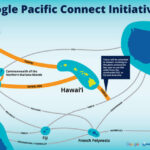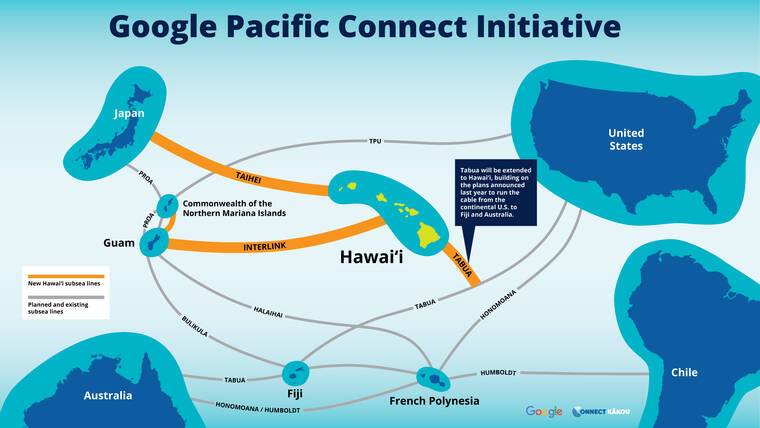What promises to be a significant step in bridging Hawaii’s digital divide — a $1 billion project to build undersea fiber-optic internet cables — was unveiled Tuesday in Honolulu.
Lt. Gov. Sylvia Luke, leader of Hawaii’s Connect Kakou high-speed internet initiative, and Benji Robinson, Google’s director of Asia/Pacific network planning and acquisition, met the press to talk about Google’s Pacific Connect Initiative.
Google’s $1 billion investment will finance three cables that will connect Hawaii with the continental U.S., Japan, Fiji, Australia, Guam and the Commonwealth of the Northern Marianas Islands, or CNMI.
“With this, Hawaii now becomes a key digital hub in the Pacific,” Robinson said. “Submarine cables are the backbone of the internet. Human connectivity today depends on them more than any other kind of infrastructure.”
Robinson said the cables are narrow, about the diameter of a garden hose, “but their impact on connecting people and businesses and governments is huge.”
“Society depends on the internet. Core industries such as health care, education and even shopping are now heavily dependent upon a reliable internet,” Robinson said.
Luke expressed excitement about Google’s plans, and hinted that an upgrade to Hawaii’s internet infrastructure is long overdue.
“In Hawaii, our connectivity is reliant on three major undersea cables, and two of these cables are nearing the end of their operational lifespans,” the lieutenant governor said. “That is something that is really critical for Hawaii residents to understand.
“Hawaii has been bypassed, in fact, over the years, and has not seen recent significant upgrades to existing undersea cables.”
Robinson said Google and the state are partnering with numerous others to bring the project to fruition — “companies like Vocus, Fintel, OPT, Telstra and governments including CNMI and Guam.”
“Building cables of this size and scope are multiyear projects, often taking three to five years to complete construction,” he said. “We are targeting the earliest completion dates of these cables in 2026, though that will depend on a variety of factors, even including the weather.”
Luke said the partnership “enhances connectivity for our communities, and the economic opportunities that it will provide.”
“These are not just simply upgrades to old systems,” she said. “They are brand-new undersea cables and essential to keeping Hawaii connected to the entire world. On behalf of our state, I want to thank Google for the significant investment in our communities in progressing digital infrastructure.”
Luke’s office said that in addition to Google’s commitment, Hawaii is expecting more than $320 million in federal funding over the next five years to build critical internet infrastructure statewide and increase digital literacy and equity. In March, Hawaii’s Digital Equity Plan was approved by the federal government, a major step toward prioritizing federal funding for the development of digital equity projects and programs.
In collaboration with Gov. Josh Green, Luke launched Connect Kakou with partners from the Hawaii Broadband and Digital Equity Office, the University of Hawaii, the Department of Hawaiian Home Lands and multiple other state and county agencies. The initiative’s goal is to ensure people from all walks of life have reliable access to high-speed internet, as well as the tools and knowledge to safely and confidently use the internet.
Public information sessions for the overall Connect Kakou initiative are continuing across the islands. Visit ConnectKakou.org for a list of upcoming information sessions and initiative updates.
Email John Burnett at jburnett@hawaiitribune-herald.com.















